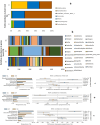Impact of artisanal refining activities on bacterial diversity in a Niger Delta fallow land
- PMID: 38365802
- PMCID: PMC10873323
- DOI: 10.1038/s41598-024-53147-4
Impact of artisanal refining activities on bacterial diversity in a Niger Delta fallow land
Abstract
Hydrocarbon pollution is a major ecological problem facing oil-producing countries, especially in the Niger Delta region of Nigeria. In this study, a site that had been previously polluted by artisanal refining activity was investigated using 16S rRNA Illumina high-throughput sequencing technology and bioinformatics tools. These were used to investigate the bacterial diversity in soil with varying degrees of contamination, determined with a gas chromatography-flame ionization detector (GC-FID). Soil samples were collected from a heavily polluted (HP), mildly polluted (MP), and unpolluted (control sample, CS) portion of the study site. DNA was extracted using the Zymo Research (ZR) Fungi/Bacteria DNA MiniPrep kit, followed by PCR amplification and agarose gel electrophoresis. The microbiome was characterized based on the V3 and V4 hypervariable regions of the 16S rRNA gene. QIIME (Quantitative Insights Into Microbial Ecology) 2 software was used to analyse the sequence data. The final data set covered 20,640 demultiplexed high-quality reads and a total of 160 filtered bacterial OTUs. Proteobacteria dominated samples HP and CS, while Actinobacteria dominated sample MP. Denitratisoma, Pseudorhodoplanes, and Spirilospora were the leading genera in samples HP, CS, and MP respectively. Diversity analysis indicated that CS [with 25.98 ppm of total petroleum hydrocarbon (TPH)] is more diverse than HP (with 490,630 ppm of TPH) and MP (with 5398 ppm of TPH). A functional prediction study revealed that six functional modules dominated the dataset, with metabolism covering up to 70%, and 11 metabolic pathways. This study demonstrates that a higher hydrocarbon concentration in soil adversely impacts microbial diversity, creating a narrow bacterial diversity dominated by hydrocarbon-degrading species, in addition to the obvious land and ecosystem degradation caused by artisanal refining activities. Overall, the artisanal refining business is significantly driving ecosystem services losses in the Niger Delta, which calls for urgent intervention, with focus on bioremediation.
© 2024. The Author(s).
Conflict of interest statement
The authors declare no competing interests.
Figures




References
-
- Izah S. Ecosystem of the Niger-Delta region of Nigeria: Potentials and threats. Biodivers. Int. J. 2018;2:338–345. doi: 10.15406/bij.2018.02.00084. - DOI
-
- Kadafa AA. Oil exploration and spillage in the Niger Delta of Nigeria. Civ. Environ. Res. 2012;2:38–51.
-
- Enyoghasim, M. O. Oil exploration and exploitation in Nigeria and the challenge of sustainable development: An assessment of the Niger Delta. 670216917 (2019).
-
- Nwozor A, Audu J, Adama IJ. The political economy of hydrocarbon pollution: Assessing socio-ecological sustainability of Nigeria’s Niger Delta region. Int. J. Energy Econ. Policy. 2018;9:1–8.
MeSH terms
Substances
LinkOut - more resources
Full Text Sources
Research Materials
Miscellaneous

